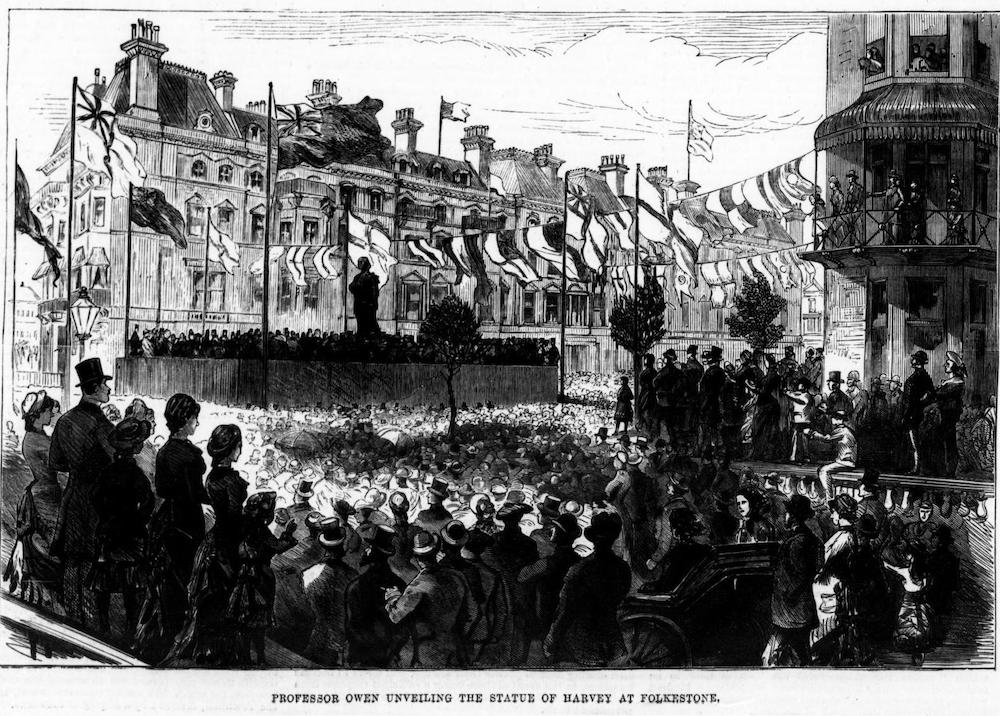

Monument to William Harvey, Discoverer of the Circulation by Albert Bruce-Joy. 1881. Marble. Clifton Gardens, Folkestone, Kent. [Click on the images to enlarge them.] According to the write-up of the unveiling in the Illustrated London News explained, the fund for raising the statue was started on Harvey's tercentenary commemoration, and a "numerous company from London, including some of the professional and scientific men attending the International Medical Congress last week, went down to Folkestone ... for the ceremony of unveiling" (157) which was performed by none other than Professor Richard Owen.


The Illustrated London News reporter continues,
The statue of William Harvey now erected at Folkestone is a bronze figure, eight feet high, sculptured by Mr. Albert Bruce Joy; it is placed on a granite pedestal, at the west end of the Lees, adjacent to Castle Hill avenue, facing the sea, and not far from the site of the house which was Harvey’s birthplace. For the occasion of last Saturday the directors of the South-Eastern Railway Company, of whom Sir Edward Watkin, M.P., is chairman, had granted a special train to bring down the guests of the Folkestone Mayor and Corporation from London.... The Mayor of Folkestone, Mr. J. B. Tolputt, with the Aldermen and Town Councillors, in their robes, and with Sir Edward Watkin and other gentlemen, met the train at Shorncliffe station; and a number of carriages were ready to convey the visitors to the inclosed space and raised platform around the Harvey statue. [157]


Of special interest is the plea put forward by Owen, in his speech, on behalf of vivisection:
Professor Owen, in his address before unveiling the statue, explained how the methods and results of Harvey’s discovery have not only laid the foundation of all progress in physiology, but have been the basis of modern scientific medicine and surgery, and consequently the source of countless blessings to suffering humanity. From this point Professor Owen passed into a disquisition on the experiments and discoveries of Harvey and his follower, Hunter, showing the value of vivisection as the helpmate of surgical research and discovery, and without which we should still be in the dark ages of science as regarded the healing profession. In conclusion, he remarked that it seemed to him to be a public duty germane to the memory of the "great vivisector" to oppose a now threatened appeal to the Legislature totally to prohibit such experiments as those to which mankind was indebted for Harvey’s and Hunter’s great discoveries. He was prepared to prove, on all fitting occasions, the mode and degree in which vivisection imparted the power of diminishing and removing the sufferings of our fellow-men. The learned Professor concluded by presenting, on behalf of the committee and subscribers, the memorial to the Mayor and Corporation of Folkstone. [158]
Not many would agree with his pro-vivisection argument now, but it is a sobering thought that, however humanely experiments are conducted now, foundational advances in medicine were, in fact, made by inflicting terrible suffering on animals.
At the end of the unveiling ceremony, "Canon Jennings offered a prayer; and, after a few words from Dr. Bowles to his medical brethren of the town, the company adjourned to the Townhall, where luncheon was provided under the presidency of the Mayor. Professor Owen proposed 'The memory of Harvey,' which was drunk in silence.... Most of the party returned to town in the evening by special train" (158)
These images may be used without prior permission for any scholarly or educational purpose as long as you (1) credit the photographer or person who scanned the illustrations and (2) link your document to this URL in a web document or cite the Victorian Web in a print one.
Bibliography
"The Harvey Statue at Folkestone." The Illustrated London News. Volume 79, issue 2204 (13 August 1881). Internet Archive. Digitising sponsor, the Kahle/Austin Foundation. Web. 19 July 2023.
Created 19 July 2023